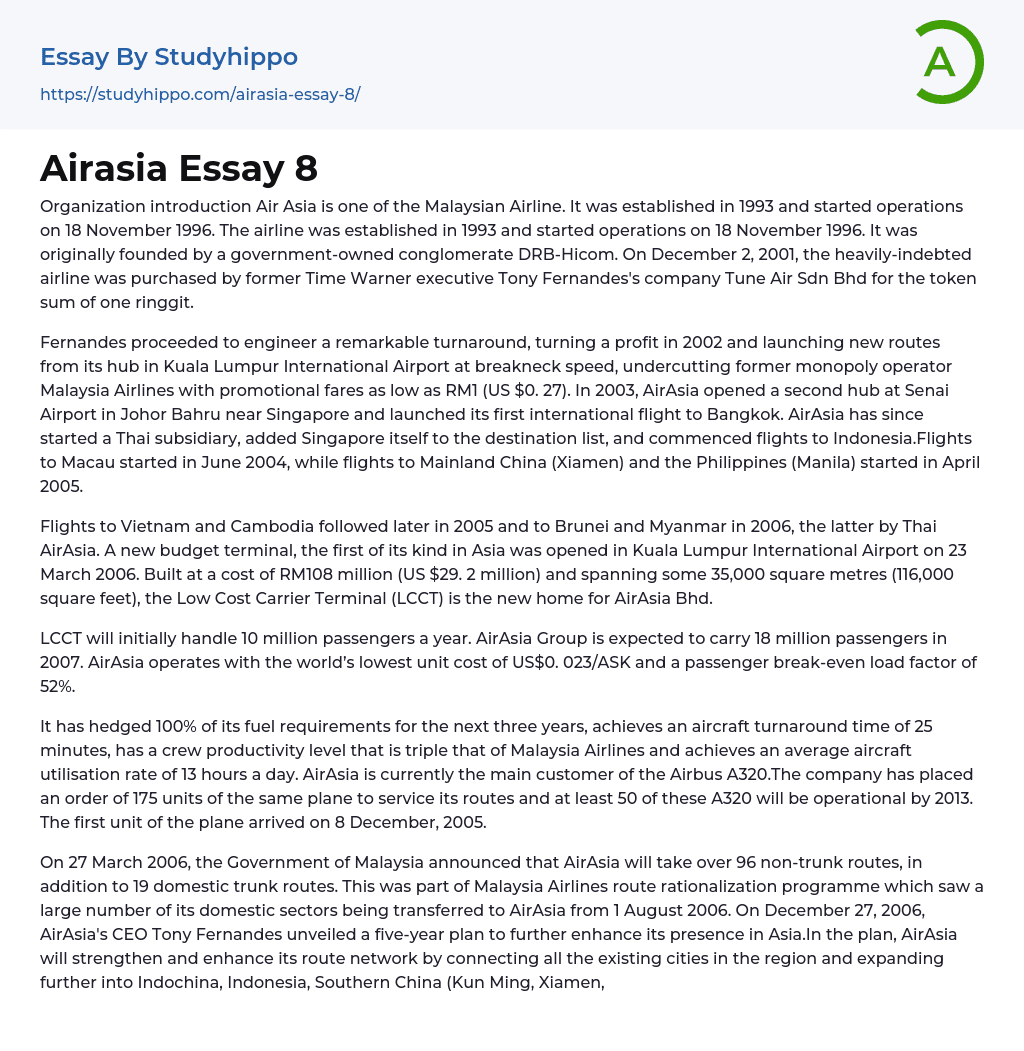Organization introduction Air Asia is one of the Malaysian Airline. It was established in 1993 and started operations on 18 November 1996. The airline was established in 1993 and started operations on 18 November 1996. It was originally founded by a government-owned conglomerate DRB-Hicom. On December 2, 2001, the heavily-indebted airline was purchased by former Time Warner executive Tony Fernandes's company Tune Air Sdn Bhd for the token sum of one ringgit.
Fernandes proceeded to engineer a remarkable turnaround, turning a profit in 2002 and launching new routes from its hub in Kuala Lumpur International Airport at breakneck speed, undercutting former monopoly operator Malaysia Airlines with promotional fares as low as RM1 (US $0. 27). In 2003, AirAsia opened a second hub at Senai Airport in Johor Bahru near Singapore and launched its first interna
...tional flight to Bangkok. AirAsia has since started a Thai subsidiary, added Singapore itself to the destination list, and commenced flights to Indonesia.Flights to Macau started in June 2004, while flights to Mainland China (Xiamen) and the Philippines (Manila) started in April 2005.
Flights to Vietnam and Cambodia followed later in 2005 and to Brunei and Myanmar in 2006, the latter by Thai AirAsia. A new budget terminal, the first of its kind in Asia was opened in Kuala Lumpur International Airport on 23 March 2006. Built at a cost of RM108 million (US $29. 2 million) and spanning some 35,000 square metres (116,000 square feet), the Low Cost Carrier Terminal (LCCT) is the new home for AirAsia Bhd.
LCCT will initially handle 10 million passengers a year. AirAsia Group is expected to carry 18 million passengers in 2007. AirAsia operates with the
world’s lowest unit cost of US$0. 023/ASK and a passenger break-even load factor of 52%.
It has hedged 100% of its fuel requirements for the next three years, achieves an aircraft turnaround time of 25 minutes, has a crew productivity level that is triple that of Malaysia Airlines and achieves an average aircraft utilisation rate of 13 hours a day. AirAsia is currently the main customer of the Airbus A320.The company has placed an order of 175 units of the same plane to service its routes and at least 50 of these A320 will be operational by 2013. The first unit of the plane arrived on 8 December, 2005.
On 27 March 2006, the Government of Malaysia announced that AirAsia will take over 96 non-trunk routes, in addition to 19 domestic trunk routes. This was part of Malaysia Airlines route rationalization programme which saw a large number of its domestic sectors being transferred to AirAsia from 1 August 2006. On December 27, 2006, AirAsia's CEO Tony Fernandes unveiled a five-year plan to further enhance its presence in Asia.In the plan, AirAsia will strengthen and enhance its route network by connecting all the existing cities in the region and expanding further into Indochina, Indonesia, Southern China (Kun Ming, Xiamen, Shenzen) and India. The airline will focus on developing its hubs in Bangkok and Jakarta through its sister companies, Thai AirAsia and Indonesia AirAsia. Hence, with increase frequency and addition of new routes, AirAsia expects passenger volume to hit 18 million by end-2007.
On September 2007, AirAsia's Kuala Lumpur hub is fully operated with A320s while Thai AirAsia received its first Airbus A320 in October 2007.Indonesia AirAsia
will receive its first Airbus by January 2008. On April 5, 2007, AirAsia announced a three-year partnership with the British Formula One team AT Williams. The airline brand is displayed on the helmets of Nico Rosberg and Alexander Wurz, and on the bargeboards and nose of the cars.
Business / service operation AirAsia has progressively launched value added services. On April 24, 2007, AirAsia introduced web check-in. This made AirAsia the first airline in Malaysia to offer the ability to check in online and print out boarding passes.It is now available for Malaysian domestic travel only and for those with no check-in baggage.
On May 15, 2007, a service named "Xpress Boarding" was launched, enabling passengers to get priority boarding for a fee. This product is available in all hubs including Thai AirAsia and Indonesia AirAsia. In the pipeline, after launching web check-in and kiosk check-in, AirAsia will later introduce PDA check-in. On AirAsia X flights, passengers are given a choice of purchasing extra baggage weight, meals, comfort kit, and seat selection, all with nominal fees.
- Low-Cost Carrier essays
- Easyjet essays
- Value Chain essays
- Airbus essays
- Delta Air Lines essays
- Qantas essays
- Cars essays
- Bicycle essays
- Rms Titanic essays
- Renault essays
- Truck essays
- chrysler essays
- The city essays
- Racing essays
- Airlines essays
- Airports essays
- Boeing essays
- Aviation essays
- Emergency Management essays
- Health Insurance essays
- Insurance essays
- Life Insurance essays
- Public Transport essays
- Transportation essays
- Accounting essays
- Andrew Carnegie essays
- Automation essays
- Business Cycle essays
- Business Intelligence essays
- Business Model essays
- Business Operations essays
- Business Software essays
- Cooperation essays
- Cooperative essays
- Corporate Social Responsibility essays
- Corporation essays
- Customer Relationship Management essays
- Family Business essays
- Franchising essays
- Harvard Business School essays
- Harvard university essays
- Human Resource Management essays
- Infrastructure essays
- Inventory essays
- Logistics essays
- Management essays
- Manufacturing essays
- Market essays
- Marketing essays
- Multinational Corporation essays




